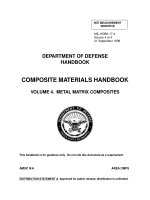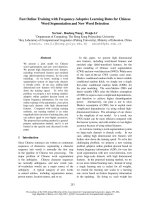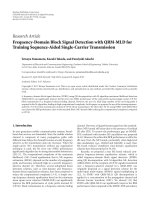17 hypertrophy training volume intesity frequency
Bạn đang xem bản rút gọn của tài liệu. Xem và tải ngay bản đầy đủ của tài liệu tại đây (512.06 KB, 28 trang )
UNIVERSITY
Hypertrophy
Training
Volume, Intensity,
Frequency
The Lesson
Interrelation of Volume, Intensity, Frequency and Execution
How to measure volume and the dose response curve
Is all volume created equal?
Should you train heavy or light?
Should you train to failure?
What are stimulating reps?
How to count volume
Picking your training Split
Definitions
Exercise type and execution: Focus/Quality of stimulus
Intensity/Effort: Magnitude of stimulus
Volume: Dosage of stimulus
Frequency: Organization of stimulus
All 4 variables are interdependent of one another (one variable effects
the other 3)
Training to failure or with heavy loads will limit the # of sets able to
perform and increase recovery time needed
Training far from failure would require more sets to make up for
stimulus. High volume might require more frequent session so one
workout isn’t too long.
The right combination of theses variables will allow optimal stimulus,
fatigue management, and training sustainability.
Volume
Three ways to quantify volume
1. Volume load (weight x reps x sets)
1.
2.
100lbs x 10 reps x 3 sets = 3000lbs
120lbs x 5 reps x 5 sets= 3000lbs
2. Total # of reps (5 sets x 10 reps = 50 reps)
3. Number of total sets
Research has found a dosage response only between number of sets
performed and hypertrophy irrespective of other variables
In 2018 systematic review, if sets are in the 6-20 rep range and near
failure the number of sets is the strongest predictor of hypertrophy.
Volume determines the dosage of mechanical tension provided, so
there is dose response to the number of sets.
Dosage of Volume for Growth Inverted UCurve
Hypertrophy
RATE OF
GROWTH
Atrophy
No Sets
Optimal Sets
Too Many Sets
More volume produces more growth up to a point, then
growth can be hindered
More is NOT always better; volume is highly fatiguing, and
recovery must be considered. Train within your recovery
capacity.
But NOT all sets are created equal
Why Are All Sets Not Equal?
Its all about the stimulating reps!
Exercise Choice and Execution (stimulus and fatigue)
1 set of leg extension vs 1 set of squat
Beginner vs Advanced lifter execution/muscle connection
Absolute and Relative Effort
1 set to failure vs 1 set 3 reps shy of failure
90% of 1 rep max vs 70% of 1 rep max
Strength level of lifter
Frequency
Fatigue accumulation
Rest periods
Short rest vs long rest periods effect fatigue dissipation
Sleep/nutrition/stress
Fatigue additions or reductions from recovery tools
Should You Train Heavy or Light?
”Absolute Effort”
Heavy >75% of 1 RM and Light <75% of 1 RM can be just as
hypertrophy as long as sets are at or near failure.
Heavy weights recruit HTMU right away and are stimulating reps
Light weights recruit HTMU at the end of the set for stimulating reps,
so you must train at/near failure
So this is about getting enough stimulating reps, the hard reps are
what matter.
Too Heavy 1-5RM? Great for strength but takes a lot of sets to accrue
enough stimulating reps. Hard on joints and connective tissue. Reps
stimulating right out the gates.
Too Light 20-30RM? Great for muscular endurance. Generates a lot of
fatigue. Takes a lot of reps to get to a few stimulating reps. Low risk of
injury
Are Hypertrophy and Strength Increase the
Same?
Muscle Mass
Larger and more myofibrillar protein means great ability to produce
force
Connective tissue and passive tissue elements increase
Neuromuscular Adaptations
Increased neural drive
Muscle activation: increased fiber recruitment and rate coding
Motor unit synchronization
Skill Acquisition
Strength specific to movement performed
To get good at lifting heavy things you must lift heavy
Strength is loading type specific; hypertrophy can occur with a variety
of loads. Strength increase does not always mean hypertrophy
increase.
Training to Failure or Not?
“Relative Effort"
Technical Failure: break down in form/technique but another rep could
still be performed
Muscular Failure: Muscle unable to perform a concentric contraction
and move the weight lifted
Benefits:
Highly stimulating
No stimulus left on the table
Always know your performance level
Time efficient, less sets needed
Disadvantages:
Higher CNS fatigue
Higher muscular damage (72 hours recovery periods)
Inter workout performance drops
Safety concerns on technical lifts
Reps in Reserve
Reps in reserve (RIR) are the amount of reps shy of failure
0 RIR = failure reached
1 RIR= 1 rep before failure
2 RIR = 2 rep before failure
In research, less than 3 RIR is suboptimal for growth
Argument that 0-2 RIR is same growth for less fatigue, claim lacks
substantial evidence at higher levels
Benefits of RIR
Fatigue management
Mentally less demanding
Sustained Performance over multiple sets
Safer on major technical lifts
Disadvantages:
Many are poor estimators of RIR
Stimulus underdosed
More gym time from more sets needed
Performance level more unknown
Training Load and Effort Effect on Stimulating
Reps
Assume the last 5 reps of a set are the “stimulating reps” for growth
4 Sets x 10 reps, 3 RIR= 40 reps (8 stimulating reps)
3 Sets x 10 reps 2 RIR = 30 reps (9 stimulating reps)
2 Sets x 10 reps, to failure = 20 reps (10 stimulating reps)
2 Sets x 4 reps, to failure = 8 reps (8 stimulating reps)
2 sets x 30 reps, to failure= 60 reps (10 stimulating reps)
All Stimulating reps are not created equal either
Training Load and Effort Effect on Stimulating
Reps
Each rep closer to failure creates high motor unit recruitment, peak
tensions and duration of tensions, so each rep is more effective
Each rep closer to failure is also more fatiguing than earlier reps
Each subsequent set can be less effective from CNS fatigue preventing
decrease motor unit recruitment as you approach failure
The more advanced you get the less stimulating the earlier reps
become, hence needing to push ALL OUT on sets.
Recommendation for Training Intensity
Absolute Effort:
75% of volume in the 6-15 rep range (60-85% 1 RM)
25% in 1-6 rep range and/or 15-25 rep range *goal and risk dependent
Relative Effort:
Beginners
Focus should be on technique and form
3-1 RIR on major compound lifts
2-0 RIR on isolation lifts
*Progress into all out sets only when technique is nailed
Intermediates and Advanced
2-0 RIR on major compound lifts *safety dependent
1-0 RIR on isolation lifts
*goal is to complete quality reps and limit missing lifts
*Do NOT go for the reps that you are to far off from, live to fight
another day
*Advanced need to train their lifts ALL OUT
Training Intensity is Lift Dependent
Lower Body Free Weight: 5-12 reps 1-2 RIR
Squat/RDL
Upper Body Free weight: 5-15 reps 1-2 RIR
BB bench, BB row
Lower body machine: 8-20 reps 1-0 RIR
Leg Press, Hack Squat
Upper Body machine: 6-20 reps 1-0 RIR
Chest Press, Pull down
Lower body isolation: 8-25 reps 1-0 RIR
Leg curl/ext
Upper body isolation: 8-25 reps 1-0 RIR
Bicep curl/tricep push down
Recommendations for Volume
Goal is to train with an optimal stimulus and be able to recover. This is
a moving target based on phase of the athlete.
Beginners and Novice
5-10 sets per muscle group per week
Intermediates/Advanced
8-20 sets per muscle group per week
These are only starting point AVERAGES and I recommend starting on
the lower end and making hard quality sets first above all.
If you train your sets ALL OUT you will need very few sets and less than
recommendations potentially for some.
We will need to move volume up and down based on phase and
recovery. Autoregulation strategies will be covered for this in future.
Consider overlap in muscles trained as well for counting volume
Counting Volume
Don’t over analysis this, just standardize how you want to count to
keep track.
Exercise/Movement
Sets per Muscle
Squat Variation
1 set quads, 1 set glutes (maybe
erectors)
Hip Hinge Variation
1 sets hams, 1 set glutes, 1 set erectors,
1 set traps
Vertical Pull
1 set lats, 1 set rear delts, 1 set biceps
Vertical Push
1 set F delts, 1 set triceps
Horizontal Pull
1 set Lats, 1 sets traps, 1 set biceps
Horizontal Push
1 set Pecs, 1 set F delts, 1 set triceps
Isolation movements
1 set target muscle
*arm work on compounds might be counted as ½ sets or only count
direct isolation work for ease of tracking
Training Frequency
Frequency is how we organize volume and intensity
All volume in one training session is not the same as volume spread
across 3 training sessions.
We want maximize per set stimulus. If doing all the work in one
session your quality of volume will turn to junk.
Volume done in one session will become less effective in the session
but much more fatiguing.
High fatigue requires longer time course for recovery
Remember: Stimulate, Recover, Sustainability
Benefits of Higher Training Frequency
Lower volume per session keeps mechanical loading high and quality
high
Lower fatigue generated per session
More frequent stimulation of protein synthesis
Improved strength gains compared to low frequency volume matched
training
Improved hypertrophy independent of volume
Higher Training Frequencies
Beginners
won’t need as many hard sets to grow and those sets wont’ create a
lot of fatigue.
Beginners can train more frequent and less per session volume. This is
how you advance FAST as a beginner.
Advanced lifters:
will need to train harder and closer to failure for a set to be effective.
This one set will generate a lot more fatigue than a novice.
You will need more volume per session as you progress in your training
career up to a point and then this may lessen.
You will also need more recovery between sessions to manage fatigue
as you progress in your training career.
Training Frequency Recommendation
Train each muscle 2-4x per week
*Muscle group dependent
*Training level dependent
Training Split Progression:
Beginner: (6-12 months)
Full body split
Intermediate: (1-2 years)
Upper, lower split
Advanced: (2+ years)
Push, Pull, Legs
Modified Push, Pull, Legs
Body part Splits
Beginner Set up
3 days per week
Full body (2-3 sets)
Off
Full body (2-3 sets)
Off
Full body (2-3 sets)
Off
Off
Repeat
4 days per week
Full body
Off
Full body
Off
Upper
Lower
Off
Repeat
Intermediate Set Up
4 days per week
Upper (3-5 sets)
Lower (3-5 sets)
Off
Upper (3-5 sets)
Lower (3-5 sets)
Off
Off
Repeat
5 days per week
Pull
Push
Legs
off
upper
Lower
Off
Repeat
Advanced Set Up
3on 1 off
Pull (4-8 sets)
Push (4-8 sets)
Legs (4-8 sets)
Off
Repeat
2 on 1 off
Push
Pull
Off
Legs
Push
Off
Legs
Pull
Off
Repeat
5-day rotation
Push
Pull
Off
Legs
Off
Repeat
Advanced Specialization Cycles
Back focus
Push (4-6 sets)
Pull (horizontal;
4-8 sets)
Off
Legs (4-6 sets)
Pull (vertical; 4-8
sets)
Off
Repeat
Leg focus
Legs (ham/back)
Push
Off
Legs (quads)
Pull
Off
Repeat
Push focus
Pull
Push (Chest)
Off
Legs
Push (delt/tri)
Off
repeat
Arm focus
Push
Pull
Arms
Legs
Off
Repeat
Training Split Selection
You do NOT want to be advanced. Work your way up and get the most
out of the least.
Your split selection is based on your level but also what you need for
stimulus and your ability to recover from that stimulus.
The choice will determine the number of lifts per day and the number
of sets per session and also the session duration







![oecd economic surveys [electronic resource] russian federation - volume 2006 issue 17.](https://media.store123doc.com/images/document/14/y/io/medium_ioa1401363244.jpg)

